HTDS Guide – Findings and Interpretations
‹View Table of Contents
Return to The Hanford Thyroid Disease Study page
Section Summary
- The HTDS is a scientific study conducted to determine whether there was an increased risk of developing thyroid disease among people exposed to iodine-131 from Hanford.
- The HTDS data show that the risks of thyroid disease were about the same regardless of the radiation doses people received.
- The findings mean that if there is an increased risk of thyroid disease from exposure to Hanford’s iodine-131, it is probably too small to observe using the best epidemiologic methods available.
- Researchers found that the occurrence of thyroid disease in the study group was about the same as has been reported for other populations.
The HTDS is an epidemiological study conducted to determine whether thyroid disease is increased among people who were exposed as young children to releases of iodine-131 from the Hanford Nuclear Site from 1944 through 1957.
The HTDS was designed to test whether the risk of thyroid disease in a group of people exposed to Hanford’s iodine-131 differed in relation to the radiation doses their thyroid glands received. The study cannot determine the cause of an individual’s disease.
The HTDS data show that the risks of thyroid disease were about the same regardless of the radiation doses people received. In other words, no associations between Hanford’s iodine-131 and thyroid disease were observed.
The findings do not prove that Hanford radiation had no effect on the health of the area population. However, the findings show that if there is an increased risk of thyroid disease from exposure to Hanford’s iodine-131, it is probably too small to observe using the best epidemiologic methods available.
Researchers studied all types of thyroid disease, as well as a disease of the parathyroid glands called hyperparathyroidism, and abnormalities of the thyroid gland that can be seen only on ultrasound examinations.
In each case, the results were the same. The percentages of people with each kind of thyroid disease or with ultrasound abnormalities were about the same regardless of their estimated radiation dose from Hanford’s iodine-131. There were no statistically significant dose-responses for any of the diseases or ultrasound abnormalities studied.
Thyroid disease was found in the study population. This was expected because thyroid disease is common in other populations, especially among older people and women.
Researchers found that the rates of thyroid disease in the HTDS population were generally consistent with the rates of disease detected in other populations.
Thyroid Disease
Researchers studied all kinds of thyroid disease, including thyroid cancer (see Figure 1), benign thyroid nodules (see Figure 2) and hypothyroidism or underactive thyroid (see Figure 3).
For each type of thyroid disease, the study found that people with higher doses had about the same amount of disease as people with lower doses.
Hyperparathyroidism
The study found no evidence that the risk of hyperparathyroidism increased with increasing radiation dose. This disease occurs when the parathyroid glands produce too much parathyroid hormone, resulting in high calcium levels in the body.
However, the study did detect a statistically significant relationship between radiation dose and decreasing calcium levels. Average levels of calcium in the blood were slightly lower – though still within the normal range – in people with higher estimated thyroid radiation doses.
Researchers have no explanation for the finding. Nevertheless, the decrease in calcium levels was so small that even participants with the highest doses had calcium values within the normal range.
Non-Disease Outcomes
The proportion of participants with thyroid abnormalities that could be seen on their ultrasound examinations did not increase significantly with increasing radiation dose (see Figure 4).
Mortality in the Study Population
Of the 5,199 people originally identified for inclusion in the study, researchers found that 527 were deceased. Researchers were able to locate death certificates for 504 of the 527 deceased individuals. None of the death certificates indicated that any thyroid disease, including thyroid cancer, was responsible for any of the deaths.
Overall mortality rates in the study population were about the same as those in the state of Washington for the same time period. However, mortality rates for non-hereditary causes due to conditions that occurred before or shortly after birth were somewhat higher than those in the state of Washington for the same period. The reasons for this higher death rate are not known, though it is not likely related to Hanford’s iodine-131 because increased death rates from these kinds of conditions occurred even before the releases of iodine-131 from Hanford began.
Figure 1
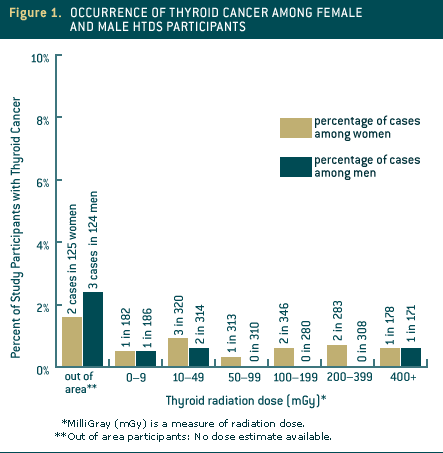
Figure 2
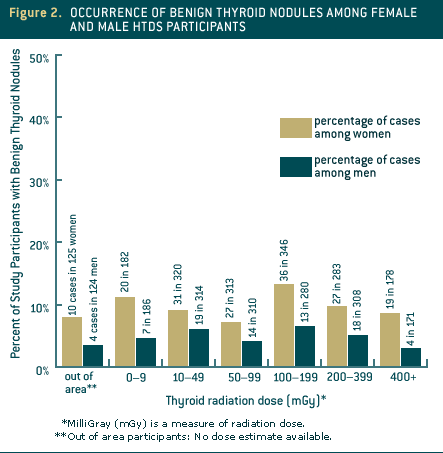
Figure 3
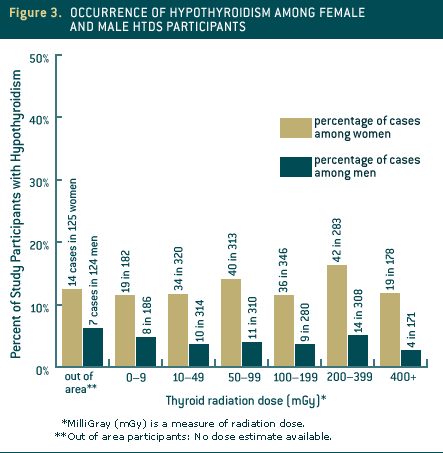
Figure 4
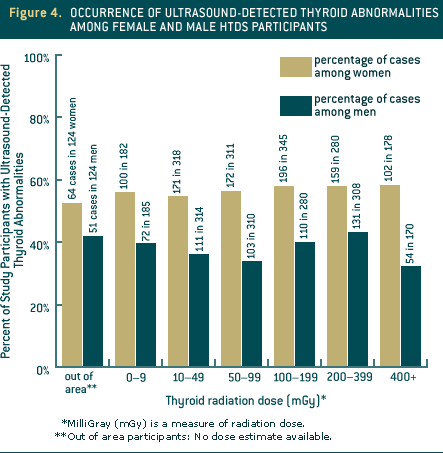
People often ask how the occurrence of thyroid disease in the HTDS compares to other populations not exposed to iodine-131 from Hanford. Based on a descriptive analysis of the most comparable information from other studies, the HTDS research team found that the rates of thyroid disease in the study population are generally consistent with the published literature on other populations. In other words, there is no indication that the levels of disease in the HTDS population are any higher than what have been reported around the world in a variety of different circumstances.
There are a number of reasons why a more definitive comparison between the HTDS population and other populations groups is not possible:
- There are no national estimates of thyroid diseases to which the HTDS can be compared. Moreover, populations with different characteristics and different exposures may exhibit very different disease rates.
- Identification of thyroid disease in a population depends to a large extent on how aggressively one looks for the disease. For example, scientists are much more likely to detect thyroid nodules using ultrasound (such as the HTDS) than they would conducting a routine thyroid examination.
- Physicians use different definitions of various thyroid and other conditions, making it difficult to compare prevalence of diseases in different populations. Such is the case with both hyperparathyroidism and hypothyroidism.
- The methods used for detecting thyroid disease and other conditions have changed, making it difficult to compare studies conducted during different time periods. For example, estimates of the prevalence of autoimmune thyroiditis and thyroid nodules vary widely depending on the method of detection.
Nevertheless, the best estimates of the prevalence of thyroid diseases, including thyroid cancer, in the general population are consistent with that found in the HTDS population group.
No other radiation studies are directly comparable to the Hanford situation, and drawing comparisons with other studies is difficult because many factors affect thyroid health. Factors include the type of radiation (internal or external), the doses received, the rate at which the doses were received, how much non-radioactive iodine a person gets in his or her diet, a person’s age at the time of exposure, how much time has passed since the exposure and the methods researchers used to search for the disease.
Nevertheless, much can be learned from other radiation studies. For example, scientists agree that high doses of external radiation, as well as high doses of internal radiation received in short periods of time, increase the risk of certain thyroid diseases. There is also evidence that the risk from radiation is greater for people exposed at younger ages.
Much less is known about situations such as Hanford, where populations are exposed to lower levels of internal radiation from iodine-131 over prolonged periods of time.
The following is a review of other important radiation studies (refer to the chart below).
External Exposures
Studies of survivors of the atomic bombings of Hiroshima and Nagasaki during World War II show that people exposed to high levels of external gamma radiation face an increased risk of thyroid cancer. People whose thyroid glands were exposed in childhood to high levels of external radiation from x-ray treatments of the head and neck are also at increased risk. (Medical uses of x-ray treatments of children have changed since the 1960s.)
What distinguishes these situations from Hanford is that the exposures were external and not from iodine-131, the radiation doses were much higher and the doses were delivered in very short periods of time.
Mix of Internal and External Exposures
Studies show that children and adults exposed to internal and external radiation from nuclear testing in the Marshall Islands (largest test in 1954) have an increased risk of thyroid nodules. Other studies show a large increase in thyroid cancer among children exposed to iodine-131 and other radiation from Chernobyl in 1986.
Neither situation is directly comparable to Hanford because the radiation received in both instances was a mixture of internal and external exposures, and the doses were higher and delivered over shorter periods of time. In the case of Chernobyl, iodine deficiency in the population may also be a factor in the rate of thyroid disease.
A study of people exposed as children to fallout from nuclear testing in the 1950s at the Nevada Test Site is called the Utah Study. This study found an increased risk of thyroid neoplasia, which is a category of disease that the researchers defined to include both thyroid cancer and certain kinds of benign nodules. However, there was no clear evidence that the risk of thyroid cancer alone was increased.
The study is considered the most comparable to the Hanford situation, but there are important differences. While exposure was largely from iodine-131, it also likely included short-lived radioactive iodines as well as external radiation. In addition, the Utah exposures were concentrated over shorter time periods.
Internal Exposures
There have been epidemiological studies of the effect of iodine-131 alone. However, these have all been based on people who received iodine-131 to treat thyroid disease, or to diagnose suspected thyroid disease. People exposed to radioactive iodine for medical reasons (primarily for the treatment of Graves disease) generally received very high doses. While several studies found an increased risk of thyroid cancer, the researchers concluded this was likely due to the patients’ underlying thyroid diseases, not their iodine-131 exposures.
People exposed to radioactive iodine for diagnostic purposes received much lower doses. Studies have not found an increased risk of thyroid cancer associated with diagnostic exposures.
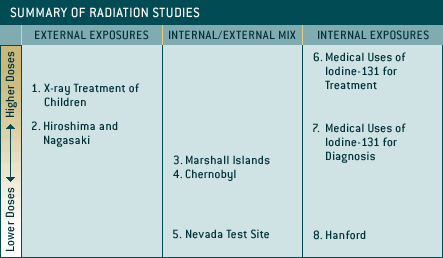
-
X-ray Treatment of Children
- Exposure to x-ray treatment.
- Exposure lasted seconds to minutes.
- Studied exposure in childhood.
- Exposure resulted in increased risk of thyroid cancer.
-
Hiroshima and Nagasaki
- Exposure primarily to gamma rays; some neutron exposure.
- Exposure lasted seconds.
- Studied exposure at all ages.
- Exposure resulted in increased risk of thyroid cancer, with greatest risk in children; limited evidence of an increased risk of autoimmune thyroiditis.
-
Marshall Islands
- Exposure to iodine-131 plus other internal and external radionuclides.
- Exposure lasted weeks.
- Studied exposure at all ages.
- Exposure resulted in increased risk of thyroid nodules and hypothyroidism, primarily in children.
-
Chernobyl
- Exposure to iodine-131 plus other internal and external radionuclides.
- Exposure lasted days to weeks.
- Studied exposure in childhood.
- Exposure resulted in large increased risk of thyroid cancer in children. Iodine deficiency in the diet may also be a contributing factor.
-
Nevada Test Site
- Exposure to iodine-131 plus other internal and external radionuclides.
- Exposure lasted weeks to months.
- Studied exposure in children.
- Exposure resulted in increased risk of thyroid nodules; some indication of an increased risk of thyroid cancer.
-
Medical Uses of Iodine-131 for Treatment
- Exposure to iodine-131.
- Exposure lasted days to weeks.
- Studied exposure at all ages, primarily adults.
- Exposure resulted in increased risk of hypothyroidism (intent of the treatment); no clear evidence of an increased risk of thyroid cancer from iodine-131 exposure.
-
Medical Uses of Iodine-131 for Diagnosis
- Exposure to iodine-131.
- Exposure lasted days to weeks.
- Studied exposure at all ages, primarily adults.
- Exposure not associated with an increased risk of thyroid cancer.
-
Hanford
- Exposure almost entirely to iodine-131.
- Exposure lasted months to years.
- Studied exposure in children.
- Exposure not associated with an increased risk of thyroid disease.
How Reliable Are the Results of the HTDS?
An important consideration in any epidemiological study is the reliability of the information. In the case of HTDS, researchers could be confident that their assessments of thyroid disease were very reliable because participants received thorough examinations of their thyroid glands by experienced doctors.
On the other hand, estimating radiation doses to the participants’ thyroid glands was inherently uncertain. This is because their doses depended not only on where they lived, but also on the quantities and sources of the food and milk products they consumed when they were infants and young children during 1944 through 1957. Highly accurate recollection of information from so long ago is simply not possible. In addition, the amounts of iodine-131 released from Hanford, and how that iodine-131 moved through the environment, are not known exactly.
In order to account for the effects of this uncertainty about the participants’ doses, HTDS researchers performed special statistical analyses. They also examined whether risks of thyroid diseases and thyroid ultrasound abnormalities differed according to where the participants lived and/or how much milk they consumed, rather than their estimated doses. None of these additional analyses led to a conclusion that risks of thyroid disease increased with increasing exposure to Hanford’s iodine-131.
No epidemiological study can state with absolute certainty whether or not an exposure (such as Hanford’s iodine-131) has affected people’s health. Nevertheless, studies such as the HTDS can be conducted in ways, and with enough participants, to provide confidence that if an association exists it is likely small. In the HTDS, scientists did not observe an association using a careful study design, thorough clinical evaluation, and several alternative approaches for estimating radiation dose and analyzing study data.